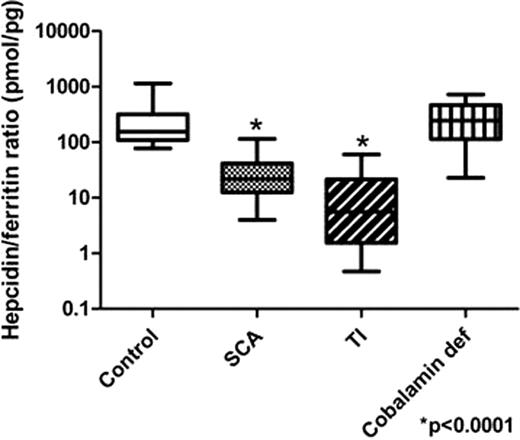Abstract
Abstract 346
Ineffective erythropoiesis in thalassemias and congenital dyserythropoietic anemia has been associated with hepcidin deficiency and spontaneous iron overload, potentially mediated by an abnormally high production of GDF-15, a cytokine overexpressed by maturing erythroblasts (Tanno et al. Nat Med 2007;13:1096–101; Tamary et al., Blood 2008; 112:5241–5244). In this study, we focused on analyzing hepcidin levels in different disorders affecting red cell production.
Twenty patients with transfusion independent β-thalassemia intermedia (TI) were enrolled as a model of hemoglobinopathy with ineffective erythropoiesis, and were compared to 53 patients with sickle cell anemia (SCA), in which erythropoiesis is effective. Seventeen healthy volunteers and 13 patients with other anemic states with chronic hemolysis (hereditary spherocytosis, autoimmune hemolytic anemia, pyrimidine 5'-nucleotidase deficiency) were recruited for comparison. Fourteen patients with megaloblastic anemia due to cobalamin deficiency were studied before, during and after treatment as an alternative model of ineffective erythropoiesis. We have determined hepcidin levels as previously described (Ganz et al. Blood 2008;112:4292–4297), as well as serum ferritin, transferrin saturation (TS) and GDF-15 in all groups. Levels of C reactive protein (CRP) and IL-6, an inducer of hepcidin production, were also determined in controls, SCA and TI.
IL-6 levels in SCA patients were increased [mean± standard error of mean (1.69±0.22pg/ml, p=0.047)] when compared to TI (1.33±0.21pg/ml) and controls (0.77±0.18pg/ml), and although there was a positive correlation between IL-6 and hepcidin levels (rS=0.25, p=0.039) this did not correspond to an absolute increase in hepcidin in this group. Indeed, circulating hepcidin levels were lower both in TI (56.24±12.14ng/ml) and SCA patients (52.53±10.97ng/ml) than in controls and other hemolytic anemias (80.23±14.3ng/ml and 120.7±12.2ng/ml, respectively, p=0.013), and did not correlate with the elevated levels of GDF-15 found in the 3 groups of patients (p>0.05). Ferritin levels correlated with both hepcidin and GDF-15 levels (rS=0.38, p=0.0005, and rS=0.63, p<0.0001, respectively). CRP correlated only weakly with IL-6 (rS=0.26, p=0.03) and was not significantly different among the groups studied. Ferritin and TS were considerably higher in TI patients than in the remaining groups (p=0.003). Ineffective erythropoiesis in cobalamin deficiency was neither associated with spontaneous ferritin or TS elevation, nor with decreased hepcidin in spite of high GDF-15 levels. Hepcidin levels at the time of diagnosis were higher than those in SCA (p<0.01) and decreased during vitamin B12 supplementation (108.8±23.36ng/ml vs. 59.37±16.23ng/ml, p=0.045). Hepcidin/ferritin ratios were significantly lower in SCA (28.91±3.08) and TI (13.76±3.98) than in controls and cobalamin deficiency (320.1±109.2 and 279.9±60.2, respectively, p<0.0001, graph represents minimum/maximum values and quartiles), better representing relative hepcidin deficiency in hemoglobin disorders than isolated hepcidin levels.
Although both ineffective erythropoiesis and chronic hemolysis were associated with high levels of GDF-15 and low hepcidin in hemoglobinopathies as a result of erythroid compartment expansion, a similar pattern was not confirmed in other hemolytic anemias or megaloblastic anemia. In the latter case, ineffective erythropoiesis did not suppress hepcidin, and regulation of hepcidin production during recovery seemed intact and occurred independently from hepcidin-inhibitory GDF-15 production. Despite elevated IL-6 levels in SCA, chronic inflammation appeared insufficient to overcome the influence of the erythropoietic drive to increase overall hepcidin levels in these patients, but might explain why hepcidin/ferritin ratios in SCA are higher than in TI patients, and normal hepcidin/ferritin ratios corresponded to normal iron status in cobalamin deficiency patients. Our data suggest that hepcidin/ferritin ratio may be a more accurate measurement to detect patients prone to systemic iron overload secondary to increased erythropoietic activity, and corroborate the concept that chronic inflammation may protect SCA from overt iron overload to some extent.
Olbina:Intrinsic LifeSciences LLC: Employment, Equity Ownership; Hepcidin C-ELISA: Co-developer. Westerman:Intrinsic LifeSciences LLC: Employment, Equity Ownership, Membership on an entity's Board of Directors or advisory committees; Hepcidin C-ELISA: Patents & Royalties; Centocor-Ortho R&D, Inc.: Honoraria.
Author notes
Asterisk with author names denotes non-ASH members.


This feature is available to Subscribers Only
Sign In or Create an Account Close Modal